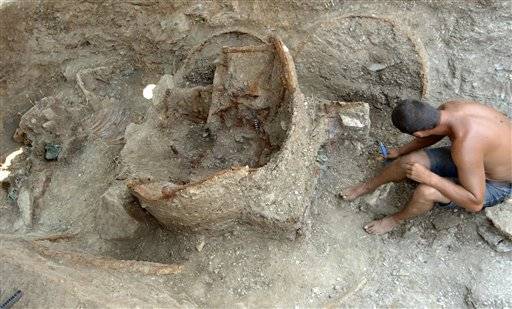불가리아서 1천900년 전 4륜전차 발굴-1,900 year old chariot
불가리아서 1천900년 전 4륜전차 발굴
[연합뉴스] 2008년 08월 08일(금) 오후 02:14
(소피아 AP=연합뉴스) 불가리아 남동부의 고대 트라키아 무덤에서 보존 상태가 매우 양호한 1천9000년 전의 4륜전차가 발견됐다고 고고학자들이 밝혔다. 불가리아 과학원의 다니엘라 아그레 발굴팀장은 7일 수도 소피아에서 동쪽으로 290km 떨어진 보리소보 마을 인근의 트라키아 시대 무덤을 발굴하면서 이 4륜전차를 찾아냈다고 밝혔다.
아그레 팀장은 "불가리아에서 이렇게 온전히 보존된 전차는 처음 발견된 것"이라며 지금까지의 전차들은 도굴 등의 이유로 일부분만 발굴됐었다고 말했다. 이 무덤에서는 도자기, 유리그릇과 함께 부유한 트라키아 귀족 전사의 장례 예물들이 발굴됐으며, 또다른 구덩이에서는 장례 때 희생된 것으로 보이는 말 2마리의 두개골과 마구로 추정되는 청동 및 가죽제 유물이 나왔다.
아그레 팀장은 불가리아 문화부가 지원한 5천레프(약 390만원) 외에 불가리아 과학원으로부터 1만레프(약 780만원)가 추가 지원돼 전차와 트라키아 유물의 기초 복원.보존 작업에 쓰일 것이라고 말했다. 불가리아 정부는 이날 "이런 전차의 발견은 유럽 최초이며 이의 보존.복원은 과학계와 불가리아를 위해 매우 중요하다"며 보리소보 마을 유적지의 연구.보존.복원에 10만레프(약 7천800만원)를 배정하기로 했다.
현지 언론들은 "무덤의 높이는 8m, 지름은 60m"라며 현재 진행되고 있는 발굴 작업은 전체 고분의 극히 일부만 드러내고 있다고 보도했다. 트라키아인들은 기원전 4천년부터 6세기까지 지금의 불가리아와 그리스, 터키, 마케도니아, 루마니아 일부 지역에 살았던 민족으로 슬라브족의 침공으로 이들에 동화됐다.
연합뉴스
****************************************
Bulgarian archaeologists discover 1,900-year-old chariot
By VESELIN TOSHKOV
Associated Press Aug 7, 08 11:24
Archaeologists have unearthed a 1,900-year-old well-preserved chariot at an ancient Thracian tomb in southeastern Bulgaria, the head of the excavation said Thursday.
Archaeologist works around a 1,900-year-old well-preserved chariot at an ancient Thracian tomb near the village of Borisovo, some 290 kilometers (180 miles) east of the Bulgarian capital Sofia, Thursday, Aug. 7, 2008. The archaeologist Daniela Agre said her team found the four-wheel chariot during excavations near the village of Borisovo. (Associated Press)
Daniela Agre said her team found the four-wheel chariot during excavations near the village of Borisovo, around 180 miles east of the capital, Sofia.
"This is the first time that we have found a completely preserved chariot in Bulgaria," said Agre, a senior archaeologist at the Bulgarian Academy of Sciences.
She said previous excavations had only unearthed single parts of chariots _ often because ancients sites had been looted.
At the funerary mound, the team also discovered table pottery, glass vessels and other gifts for the funeral of a wealthy Thracian aristocrat.
In a separate pit, they unearthed skeletons of two riding horses apparently sacrificed during the funeral of the nobleman, along with well preserved bronze and leather objects, some believed to horse harnesses.
The Culture Ministry confirmed the find and announced $3,900 in financial assistance for Agre's excavation.
Agre said an additional amount of $7,800 will be allocated by the Bulgarian Academy of Sciences for an initial restoration and conservation of the chariot and the other Thracian finds.
The Thracians were an ancient people that inhabited the lands of present day Bulgaria and parts of modern Greece, Turkey, Macedonia and Romania between 4,000 B.C. and the 6th century, when they were assimilated by the invading Slavs.
Some 10,000 Thracian mounds _ some of them covering monumental stone tombs _ are scattered across Bulgaria.
